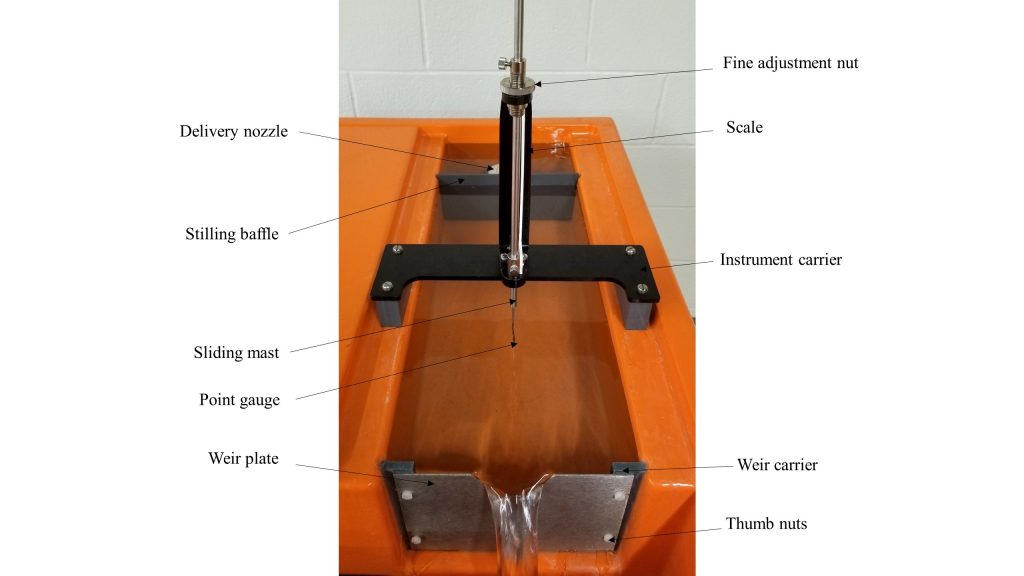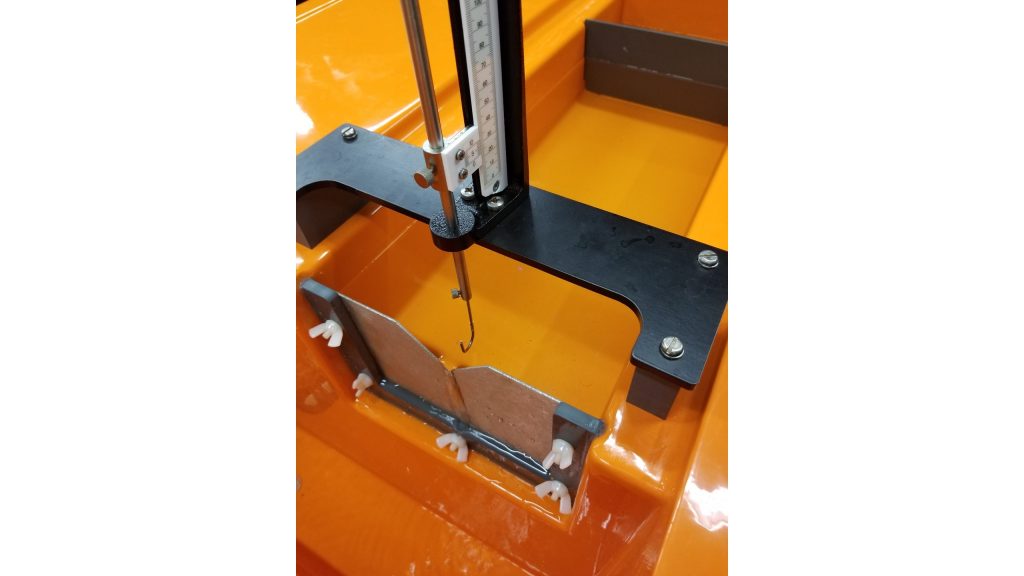Staff Gauge Reading on a Square Notch Weir Plate
Experiment #9: Flow Over Weirs
1. Introduction
A weir is a barrier beyond the width of a river or stream that alters the characteristics of the menstruum and usually results in a change in the height of the h2o level. Several types of weirs are designed for application in natural channels and laboratory flumes. Weirs can be broad-crested, curt-crested, or sharp-crested. Precipitous-crested weirs, commonly referred to as notches, are manufactured from precipitous-edged thin plates. The relationship between the menses rate and water depth above the weir can be derived by applying the Bernoulli's equation and past making some assumptions with regard to caput loss and pressure distribution of the flow passing over the weir. A coefficient of discharge needs to exist determined experimentally for each weir to account for errors in estimating the flow rate that is due to these assumptions.
2. Practical Application
Weirs are unremarkably used to measure or regulate flow in rivers, streams, irrigation canals, etc. Installing a weir in an open channel system causes disquisitional depth to form over the weir. Since there is a unique relationship between the disquisitional depth and discharge, a weir can be designed every bit a flow-measuring device. Weirs are also built to enhance the water level in a channel to divert the catamenia to irrigation systems that are located at college elevations.
3. Objective
The objectives of this experiment are to:
a) make up one's mind the characteristics of flow over a rectangular and a triangular weir, and
b) determine the value of the discharge coefficient for both notches.
4. Method
The coefficients of discharge are determined by measuring the acme of the water surface to a higher place the notch base and the corresponding menstruation rate. The general features of the flow can be adamant past direct ascertainment.
5. Equipment
The following equipment is required to perform the flow over weirs experiment:
- F1-10 hydraulics bench;
- F1-thirteen rectangular and triangular weirs;
- Vernier height guess; and
- Stopwatch.
6. Equipment Description
The menstruum over the weir apparatus includes the following elements that are used in conjunction with the flow channel in the molded bench top of the hydraulics bench (Figure 9.ane).
- A combination of a stilling baffle and the inlet nozzle to promote smooth menstruum conditions in the channel.
- A vernier claw and point guess, mounted on an instrument carrier, to allow measurement of the depth of flow above the base of operations of the notch.
- The weir notches that are mounted in a carrier at the outlet end of the menses channel [9].

vii. Theory
The depth of h2o above the base of a weir is related to the flow charge per unit through it; therefore, the weir tin be used every bit a menstruum measuring device. The relationships of flow over weirs can be obtained by applying the energy equation from a point well upstream of the weir to a bespeak just higher up the weir crest. This approach requires a number of assumptions, and it yields the following results:
- for a triangular weir (Figure 9.2a):
![]()
- for a rectangular weir (Effigy ix.2b):
![]()
where:
Q : catamenia rate;
H : top in a higher place the weir base;
b : width of rectangular weir (R-notch);
![]() : bending of triangular weir (V-notch);
: bending of triangular weir (V-notch);
Cd : belch coefficient to account for the effects of simplifying assumptions in the theory, which has to be adamant by experiment [9].

- for a V-notch
![]()
- for a R-notch:
![]()
8. Experimental Process
This experiment will be performed past taking the following steps:
- Ensure that the hydraulics demote is positioned so that its surface is horizontal. This is necessary because the period over the notch is driven past gravity.
- Mount the rectangular notch plate onto the flow channel, and position the stilling baffle as shown in Figure ix.iii.
- Plough on the pump, and slightly adjust the flow control to fill the aqueduct upstream of the weir with h2o.
- Plow off the pump when the water starts to flow over the weir.
- Wait a few minutes to permit the h2o to settle.
- Level the point gauge with the water level in the aqueduct. Record the reading as ho.
Note: To measure the datum height of the base of the notch (ho), position the instrument carrier every bit shown in Figure 9.3. Then carefully lower the guess until the betoken is just above the notch base, and lock the fibroid adjustment screw. Then, using the fine adjustment, adjust the gauge until the betoken just touches the water surface and accept a reading, being conscientious non to damage the notch.
- Adapt the signal gauge to read 10 mm greater than the datum.
- Record the reading equally h.
- Turn on the pump, and slightly adapt the flow until the water level coincides with the point gauge. Bank check that the level has stabilized earlier taking readings.
- Measure the flow charge per unit using the volumetric tank.
- Observe the shape of the nappe and take pictures of information technology.
Note: The surface of the h2o will fall as information technology approaches the weir. This is particularly noticeable at high menses rates past high heads. To obtain an accurate measurement of the undisturbed water level above the crest of the weir, information technology is necessary to identify the measuring gauge at a distance of at least three times the head above the weir.
- Increase the flow by opening the bench regulating valve to prepare the heads above the datum level in ten mm increments until the regulating valve is fully open. Take care not to let spillage to occur over the plate elevation that is adjacent to the notch. At each status, measure the catamenia rate and observe the shape of the nappe.
Annotation: To obtain a sufficiently accurate result, collect effectually 25 liters of h2o each time, or collect the h2o for at least 120 seconds.
- Close the regulating valve, stop the pump, and so supervene upon the weir with the Five-notch.
- Repeat the experiment with the Five-notch weir plate, but with 5 mm increments in water surface elevation.
- Collect seven caput and discharge readings for each weir.

9. Results and Calculations
Please visit this link for accessing excel workbook for this experiment.
9.ane. Result
Employ the following tables to record your measurements. Record any observations of the shape and the blazon of nappe, paying particular attention to whether the nappe was clinging or sprung clear, and of the end contraction and general alter in shape. (See Figure 9.4 to allocate the nappe).

Raw Data Table: R-notch
| Test No. | Datum Height ho (m) | Water Surface Elev. h(g) | Book Collected (L) | Time for Drove (due south) |
| 1 | ||||
| two | ||||
| three | ||||
| iv | ||||
| 5 | ||||
| 6 | ||||
| vii |
Raw Data Table: V-notch
| Test No. | Datum Height ho (chiliad) | Water Surface Elev. h(m) | Book Collected (L) | Fourth dimension for Collection (due south) |
| 1 | ||||
| 2 | ||||
| 3 | ||||
| 4 | ||||
| 5 | ||||
| 6 | ||||
| 7 |
9.2. Calculations
The following dimensions from the equipment can be used in the appropriate calculations:
– width of rectangular notch (b) = 0.03 m
– angle of V-notch (![]() ) = xc°
) = xc°
- Calculate belch (Q) and head (h) for each experiment, and record them in the Effect Tables. For calculation purposes, the depth of the water above the weir is the difference between each h2o level reading and the datum reading, i.due east., H = h-ho
- Summate Hfive/ii and Hthree/ii for the triangular and rectangular notches, respectively.
- For each measurement, calculate the experimental values of for the triangular and rectangular notches, using Equations 3 and four, respectively.
- Tape your calculations in the Results Tables.
Outcome Table: R-notch
| No. | H (chiliad) | Book Collected (thousand3) | Menstruation Rate (chiliadiii/s) | H 3/2 | Experimental Cd | Theoretical Cd | %Error |
| i | |||||||
| 2 | |||||||
| iii | |||||||
| 4 | |||||||
| 5 | |||||||
| six | |||||||
| 7 |
Consequence Tabular array: V-notch
| No. | H (m) | Book Nerveless (10003) | Flow Charge per unit (10003/s) | H 3/ii | Experimental Cd | Theoretical Cd | %Error |
| 1 | |||||||
| 2 | |||||||
| 3 | |||||||
| 4 | |||||||
| 5 | |||||||
| six | |||||||
| 7 |
x. Study
Apply the template provided to prepare your lab report for this experiment. Your report should include the following:
- Tabular array(s) of raw data
- Table(s) of results
- Graph(s)
- Schematic drawings or photos of the nappes observed during each experiment, with an indication of their blazon.
- Plot a graph of Q (y-axis) against H 3/2 (x-centrality) for the rectangular weir and Q against H 5/2for the triangular weir. Employ a linear function to plot the best fit, and express the relationship between Q and Hn and in the course of:
 in which the exponent value north is 1.5 for the rectangular weir and 2.5 for the triangular weir. Calculate the coefficients of discharge Cd (theoretical method) using Equations five and 6. Tape Cd values calculated from the theoretical method in the Issue Tables.
in which the exponent value north is 1.5 for the rectangular weir and 2.5 for the triangular weir. Calculate the coefficients of discharge Cd (theoretical method) using Equations five and 6. Tape Cd values calculated from the theoretical method in the Issue Tables.
- for a rectangular notch:
![]()
- for a triangular notch:
![]()
- Compare the experimental results to the theory by calculating the percentage of mistake.
- What are the limitations of the theory?
- Why would y'all expect wider variation of Cd values at lower menses rates?
- Compare the results for Cd of the weirs utilized in this experiment with those yous may find in a reliable source (e.g., textbooks). Include in your written report a copy of the tables or graphs y'all have used for textbook values of Cd .
- Discuss your observations and any source of errors in adding of Cd .
Source: https://uta.pressbooks.pub/appliedfluidmechanics/chapter/experiment-9/
0 Response to "Staff Gauge Reading on a Square Notch Weir Plate"
Post a Comment